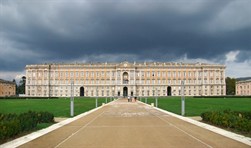Caserta
 The capital of the province of the same name in the region of Campania, Caserta boasts ancient origins, dating back to the Samnite period. The current town center already existed in the Lombard period, and during the Middle Ages it became a bishopric and was enriched by important buildings and monuments such as the cathedral and the Bishop’s Palace. The county of Caserta was born at the end of the ninth century and Pandulfo of Capua was its first Lord. Passing under the rule of several great families like the Acquaviva and Caetani, it was finally sold to the Bourbons in the eighteenth century. King Charles III decided to build the palace which still constitutes the best known landmark in Caserta at an international level. The work began in 1750 and was entrusted to the architect Luigi Vanvitelli: the result was a palace capable of competing in beauty and magnificence with the other major European royal houses, with a huge park built around the old garden of the Acquaviva and well-kept lawns, woods, fountains, lakes and waterfalls. At the end of the eighteenth century, Ferdinand IV wanted a new residence in San Leucio, with an adjoining factory used for the production of silk. The quarters of San Carlo and San Ferdinando were built for the workers in the factory and the Belvedere Palace was adorned with a magnificent garden.
The capital of the province of the same name in the region of Campania, Caserta boasts ancient origins, dating back to the Samnite period. The current town center already existed in the Lombard period, and during the Middle Ages it became a bishopric and was enriched by important buildings and monuments such as the cathedral and the Bishop’s Palace. The county of Caserta was born at the end of the ninth century and Pandulfo of Capua was its first Lord. Passing under the rule of several great families like the Acquaviva and Caetani, it was finally sold to the Bourbons in the eighteenth century. King Charles III decided to build the palace which still constitutes the best known landmark in Caserta at an international level. The work began in 1750 and was entrusted to the architect Luigi Vanvitelli: the result was a palace capable of competing in beauty and magnificence with the other major European royal houses, with a huge park built around the old garden of the Acquaviva and well-kept lawns, woods, fountains, lakes and waterfalls. At the end of the eighteenth century, Ferdinand IV wanted a new residence in San Leucio, with an adjoining factory used for the production of silk. The quarters of San Carlo and San Ferdinando were built for the workers in the factory and the Belvedere Palace was adorned with a magnificent garden.
